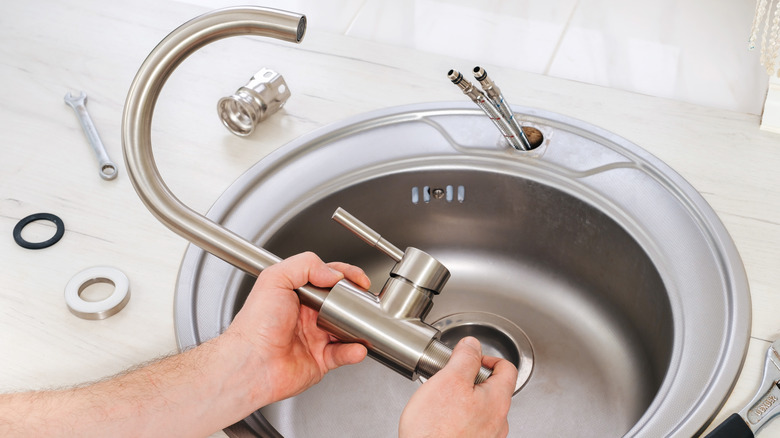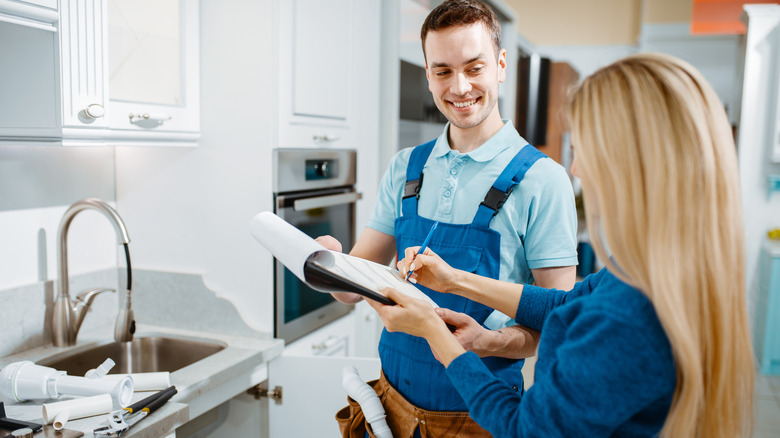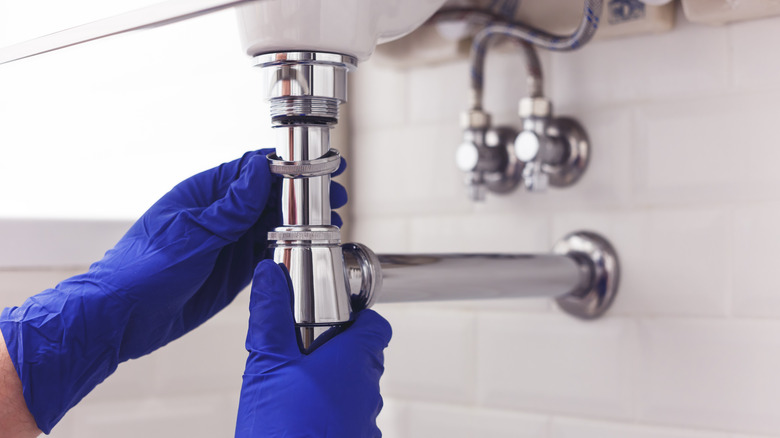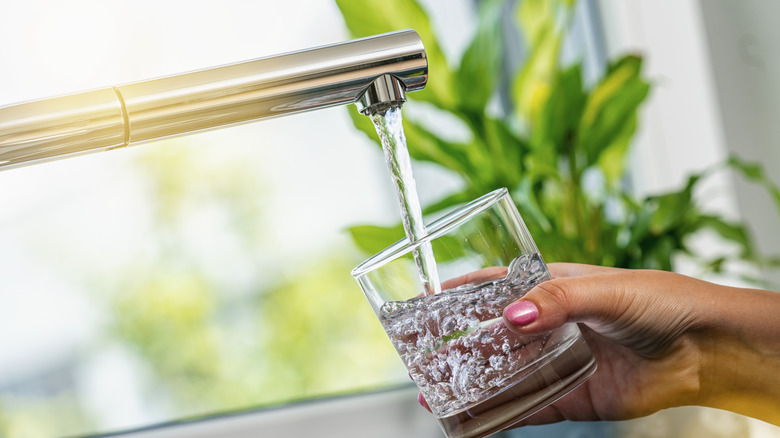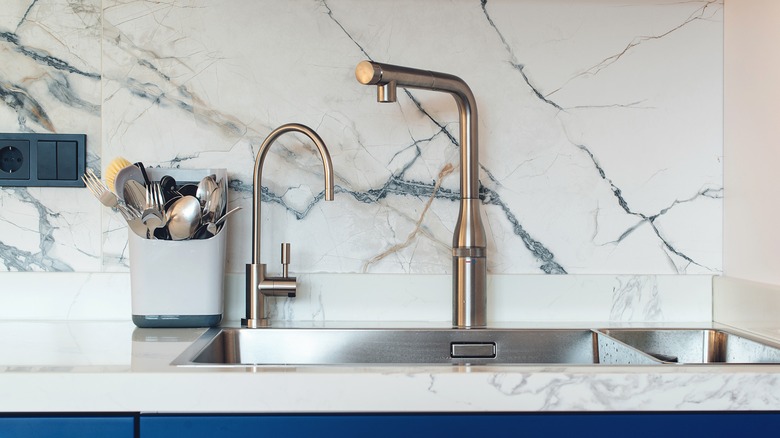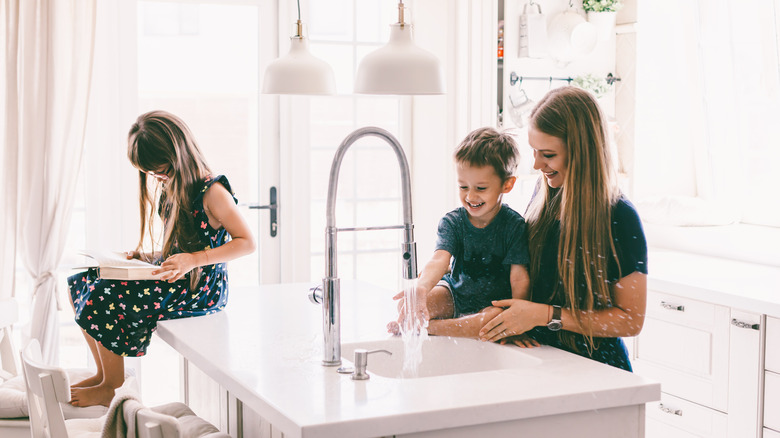How Much Does It Cost To Install A Kitchen Faucet?
A home without a functional kitchen sink can be a nightmare. Other than cleaning dishes, kitchen faucets come in handy in numerous ways in a house. Not to mention installing a new one increases the possibility of higher bids in case your property is on sale. Investing in a functional tap can turn out more beneficial to you, just like any other part of your house. Angi confirms that choosing a high-quality kitchen faucet is one of the quickest ways to add value to your home; however before you buy these kitchen gadgets, you need to understand the cost implications.
According to Fixr, the national average range for installing a kitchen tap is $300 to $800, though the cost differs from type, material, brand, and location. The type that you go for can improve and elevate your kitchen setting to another level. For example, many homeowners pay $500 for the installation of a monobloc stainless steel faucet with a pull-down sprayer and touchless operation. Monobloc faucets extend between 12 and 18 inches into the sink and go 12 to 18 inches high. Other types include antiqued copper gantry-style faucets at a maximum cost of $2,000 and chrome single-lever faucets with no spray at a low cost of $200, Fixr notes. Costs of installing brand new taps also depend on your choice of experts and where you want it installed. Read on and learn more!
Factors for cost
When selecting your preferred kitchen faucet, you have to factor in many items for the process to run smoothly. Having an idea of these aspects helps you select the best style and type and avoid unnecessary future losses. HomeAdvisor further reports that labor, along with high-end faucet designs or styles, may add to these average costs.
Location
Kitchen faucet installation consists of deck-mounted and wall-mounted taps. Countertops or sinks are used for installing deck-mounted faucets, while wall-mounted sinks usually go on the wall behind the sinks. With an average cost of $300 – $800, deck-mounted water taps are considered less costly than wall installations that range between $500 – $1,500. This is because it involves the process of opening and closing the wall during installation.
Cost by brand
When choosing kitchen faucets by the brand, you have to understand that each comes with its unique styles, finishes, and sizes, together with different features. KWC taps have the highest costs, with average prices ranging from $600 to $2,000. However, these faucets are of high quality, range in many styles and sizes, and are widely known.
Watermark makes designer taps in different finishes and features with prices ranging from $500 to $4,000, while Grohe is among the progenitor of pull-out faucet spray, known for the incredible warranties it offers. On the other hand, Delta faucets are the easiest to install, and their prices are the lowest, ranging from $85 to $400. The taps are of monobloc design, have gooseneck sprouts, and are more preferred by most homeowners.
Surface material
The surface material used on your kitchen faucet is yet another cost factor for new installations, along with the finish and color. The prices differ from plastic to brass, steel, zinc, copper, chrome, nickel, and bronze. Copper kitchen faucets are the most expensive, with prices between $175 and $1,000. The copper finish can be antiqued, polished or brushed, and have a blue or green gloss.
Zinc kitchen faucets come second with average prices of $150 to $800. They are either coated or simple. Brass kitchen taps, which comprise brass bodies or polished, antiqued, or blackened faucets with brass, range in price from $100 to $2,000. A stainless steel kitchen water tap is one of the most common lacquers, with an average price of $100 to $1,000. This is because it matches most stainless steel sinks. The price of a nickel faucet is between $90 and $1,600, although it requires more care to avert corrosion, allergies, and damage. Plastic kitchen tap with bronze or satin nickel finishing range in price from $80 to $500. Likewise, bronze kitchen faucets vary from one manufacturer to the other, with prices spanning from $65 to $800.
Type of kitchen faucet
Kitchen faucets come in several types. As a homeowner, you have to consider the aspects that make the tap outstanding according to your preference during selection. Commonly called monobloc, a single-hole kitchen faucet with a pull-out, pull-down, or no sprayer costs around $50 to $1,000. On the other hand, a single-handle kitchen water tap costs the same but requires two holes.
Pull-out faucets have spray heads in the tap body in lieu on one side, are smaller, and do not have the gooseneck. Whereas pull-down kitchen faucets have a gooseneck to the spout, they are larger and taller than pull-outs. The costs of pull-out taps vary between $125 to $300 and $150 to $1,000 for pull-down kitchen faucets. Bridge kitchen water taps are highly evaluated, with prices around $300 to $800. Designed for two holes, the faucets have a Victorian neck with two pipes extending from the deck or wall and meeting in the center at the spout.
Geographical location
The costs of installing kitchen faucets also vary from one area of residence to the other. According to HomeAdvisor, some of the estimates include New York at $190 to $400, Chicago between $190 and $390, Honolulu at $220 to $800, and Atlanta between $170 and $560.
Additional costs
When investing in kitchen faucets, it is advisable to factor in extra expenses for any unforeseen costs. According to Angi, these could be labor costs or damages instigated during installation.
Labor costs
Unlike DIY installation, hiring an expert to set up a new kitchen faucet will cost you more. This means that you will pay for any additional costs along with the tools needed and the extra hands. Moreover, you will make an extra payment for complicated tap installations that take additional time, like wall installations.
Damages during installation
Not all installation processes run smoothly, as you would expect. For this reason, you have to set aside some money for such unforeseen costs. For example, these could be expenses incurred on damages during wall installations or replacement of countertops and kitchen sink to match your new faucet.
Maintenance
Fixr reports that cleaning and maintenance of kitchen faucets depend on the brand and finishing you choose. Maintaining stainless steel and plastic is easy, unlike other finishes requiring special cleaning agents. Ensuring that you understand your water tap cleaning information will help increase its lifespan.
Types of kitchen faucets
Kitchen faucets come in a range of alternatives and styles you can choose from. Therefore, as you prepare to buy a water tap, consider not just the number of holes and handles you desire but the shape of your spout too. Below are the most common kitchen faucet types, courtesy of Fixr.
Pot filler faucets
Usually installed above the stovetop, pot filler faucets can go over large pots and pour water directly into the sink without needing to move them around. They can be folded easily to keep them out of your way when cooking. Most pot filler kitchen taps are found in larger kitchens.
Touchless faucets
Touchless kitchen water taps use sensors to turn the water on without touching the handles. These faucets are amazing to use while handling raw meat or food to avoid contracting germs. You can also turn the water temperatures through a handle situated at the base.
Single-handle faucets
Although taps usually come with two handles, this kitchen faucet type allows you to turn on the water and adjust the temperatures using the same grip. In addition, they require one hole for installation.
Pull-out faucets
Pull-out kitchen faucets are lower with a longer sprayer hose. They let you pull out the nozzle and drag it in whichever direction you want. Pull-out taps can get messy, so you have to handle them with care or risk splashing water all over the place.
Pull-down faucets
Pull-down faucets have lever handles on the side and only descend, unlike pull-outs that go all over the place. However, they come in gooseneck shapes, and their large size makes them take a more significant part of the sink.
Bridge faucets
Bridge kitchen faucets are traditional grand taps designed for two holes. They may also possibly have a third hole with the spout extending upwards from the bridge.
Why you need a new kitchen faucet
Kitchen faucets run most of the time in any home; therefore, they won't last forever, just like everything else that sees a lot of use. Replacing a new one depends on the type you chose during installation and how often you use it. Below are some of the reasons you may need a new one, as pointed out by The Punctual Plumber.
Mineral build-up
This mostly happens when your water supply is hard. Mineral build-up forms inside the kitchen faucets, thus reducing their functionality. If you can't remove it with a vinegar solution or a water softener installation, it is a sign that you need a new tap.
Rust logjam
Internal rusting of kitchen faucets and corrosion doesn't require fixing but rather an installation of new ones. The major indication of this is water taking a while to run. Failure to get another tap only leads to water leakage.
Leaking problems
Replacing worn-out and corroded faucets with new ones is crucial. Sometimes water taps go on and on leaking, and getting a new handle, or valve doesn't help the situation. Buying new faucets when your current ones are leaking can help you save costs and keep your house mold-free.
Benefits of kitchen faucets
Apart from helping with daily chores in the kitchen, faucets increase the aesthetic appeal of your house décor. Other perks of a kitchen tap, according to Banks Street Bar and Grill, include the following:
Harmonizes the kitchen
When hosting visitors, the kitchen is one of the main places people check out. A kitchen with a gooseneck faucet and pull-down functions attunes with the rest of the space and increases the beauty of your home.
Saves you money
Investing in smart kitchen taps like touchless faucets can save water bills since you'll be able to adjust the water flow and avoid wastage when in use. Besides, most smart faucets have filters that deter bacteria, thus keeping your family safe from germs.
Serves multiple roles
Faucets can be efficient in doing other extra chores in the house, such as washing hair in case of a bathroom issue and vegetables. For example, you can use pull-out kitchen taps to clean a wide space like a countertop without moving a basin.
